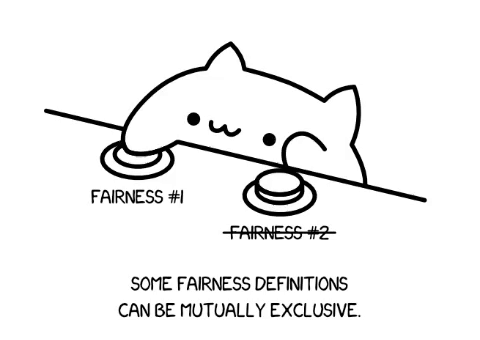Module 6: Traditional ML Methods
Topic 6: Ethics
Fairness
“But that’s not fair!”
How many times have you heard that refrain? Or even said it yourself? We often want the world to be fair but it turns out that fairness is a hard concept to encode into algorithms. Sometimes it is hard to even say what fairness is, much less turn it into something an algorithm can maximize or try to achieve.
For this section, we are going to briefly explore the concept of fairness through two different readings. One is a quick webpage primer and one is a book chapter. Then we will discuss fairness in class (hybrid) and online (asynchronous).
Readings
- The webpage Machines Gone Wrong has a nice summary of fairness metrics and will get you started on the concepts. This is probably a 10-15 min read.
- The book The Ethical Algorithm by Kearns and Roth covers a lot of great territory on ethical algorithms and how to design our algorithms to address many aspects of ethics. This includes a chapter on fairness. The book is available at the OU library and I have posted a PDF of the assigned chapter (Chapter 2 Fairness) to canvas (only available there for copyright reasons). Note, this is a relatively long chapter but it is written for a general scientific audience and I hope you will enjoy the discussion of fairness. Hybrid students need to complete the reading before class on Thursday!
Assignment
- Asynchronous students:
- Due to growing enrollment, OU has decided to change the block schedules starting in Fall 2024. Note, this is true, I’m not making it up for a class example! What I am about to make up is that OU has decided to ask you to design an autonomous scheduler that achieves fair to both faculty and students. In reality, they are not using an automated system. But we an all imagine that such a system could work really well, at least at generating a preliminary scheduler! What I want you to do is to imagine you are designing this scheduler and answer the fairness questions from the Machines Gone Wrong document. Keep in mind everything you learned in the chapter reading also. Iterate with your fellow students. The goal is that the final document could be shipped with a final such system (which we are not writing, we are only doing the design here). The document is linked in the canvas quiz, to keep it from being an open document here. Please ask any questions or discuss it on slack as needed!
- Canvas quiz link
- Hybrid students:
- Make sure you complete both reading assignments before class on Thursday! Come to class prepared to discuss. Your discussion will be similar to the topic for the asynchronous students but we will do it in class.
